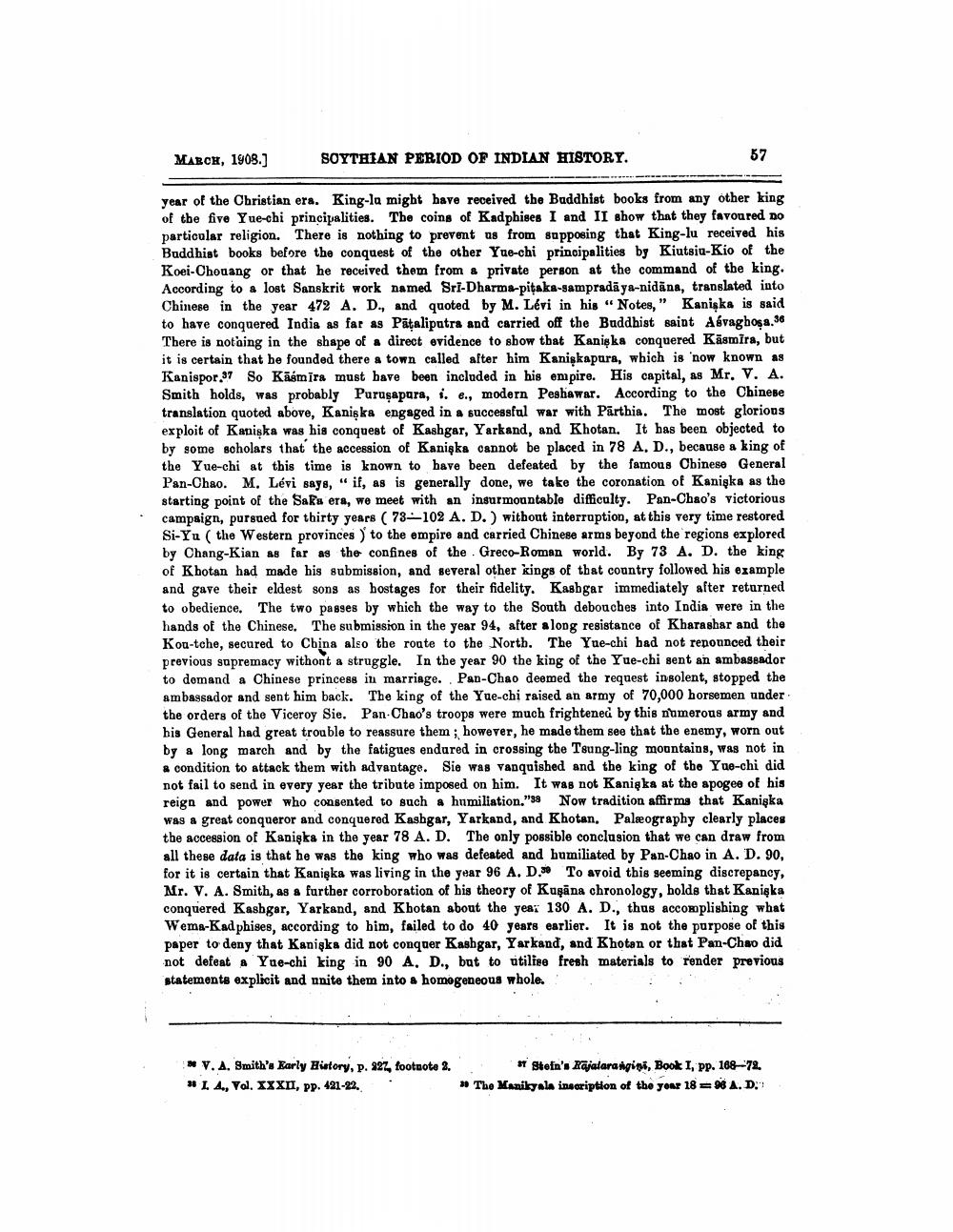________________
MARCH, 1908.)
SOYTHIAN PERIOD OF INDIAN HISTORY.
57
year of the Christian era. King-la might have received the Buddhist books from any other king of the five Yue-chi principalities. The coins of Kadphises I and II show that they favoured no particular religion. There is nothing to prevent as from supposing that King-lu received his Buddhist books before the conquest of the other Yae-chi principalities by Kiutsiu-Kio of the Koei-Chouang or that he received them from & private person at the command of the king. According to a lost Sanskrit work named Sri-Dharma-pitaka-sampradāya-nidāna, translated into Chinese in the year 472 A. D., and quoted by M. Léri in his “Notes, " Kaniska is said to have conquered India as far as Patalipatra and carried off the Buddhist saint Asvaghosa. There is nothing in the shape of a direct evidence to show that Kaniska conquered Käsmira, but it is certain that be founded there a town called after him Kanigkapura, which is now known as Kanispor 37 So Käsmīrs must have been included in his empire. His capital, as Mr. V. A. Smith holds, was probably Puruşapura, 1. e., modern Peshawar. According to the Chinese translation quoted above, Kanişka engaged in a successful war with Parthis. The most glorious exploit of Kaniska was his conquest of Kashgar, Yarkand, and Khotan. It has been objected to by some scholars that the accession of Kanişka cannot be placed in 78 A, D., because a king of the Yue-chi at this time is known to have been defeated by the famous Chinese General Pan-Chao. M. Lévi says, “ if, as is generally done, we take the coronation of Kanişka as the starting point of the Saks era, we meet with an insurmountable difficulty. Pan-Chao's victorious campaign, pursued for thirty years ( 78=102 A. D.) without interruption, at this very time restored Si-Yu ( the Western provinces ) to the empire and carried Chinese arms beyond the regions explored by Chang-Kian as far as the confines of the Greco-Roman world. By 73 A. D. the king of Khotan had made his submission, and several other kings of that country followed his example and gave their eldest sons as hostages for their fidelity. Kashgar immediately after returned to obedience. The two passes by which the way to the South debouches into India were in the hands of the Chinese. The submission in the year 94, after a long resistance of Kharashar and the Kou-tche, secured to China also the route to the North. The Yue-chi bad not repounced their previous supremacy withont a struggle. In the year 90 the king of the Yue-chi sent an ambassador to domand a Chinese princess in marriage. . Pan-Chao deemed the request insolent, stopped the ambassador and sent him back. The king of the Yue-chi raised an army of 70,000 horsemen under the orders of the Viceroy Sie. Pan-Chao's troops were much frightened by this numerous army and his General had great trouble to reassure them; however, he made them see that the enemy, worn out by a long march and by the fatigues endured in crossing the Tsung-ling mountains, was not in # condition to attack them with advantage. Sie was vanquished and the king of the Yue-chi did not fail to send in every year the tribute imposed on him. It was not Kaniska at the apogee of his reign and power who consented to such a humiliation."38 Now tradition affirms that Kaniska was a great conqueror and conquered Kasbgar, Yarkand, and Khotan. Palæography clearly places the accession of Kanigka in the year 78 A. D. The only possible conclusion that we can draw from all these data is that he was the king who was defeated and humiliated by Pan-Chao in A. D. 90, for it is certain that Kaniska was living in the year 96 A. D. To avoid this seeming discrepancy, Mr. V. A. Smith, as a further corroboration of his theory of Kuşana chronology, holds that Kanigka conquered Kashgar, Yarkand, and Kbotan about the year 130 A. D., thus accomplishing what Wema-Kad phises, according to him, failed to do 40 years earlier. It is not the purpose of this paper to deny that Kanisks did not conquer Kashgar, Yarkand, and Khotan or that Pan-Chao did not defeat a Yue-chi king in 90 A. D., but to utilise fresh materials to render previous statements explicit and unite them into a homogeneous whole.
* V. A. Smith's Early History, p. 827, footnote 2. * L 4., Vol. XXXI, pp. 421-22. .
7 Stofn'. Kājalarangini, Book I, pp. 188-72. * The Manikyala inscription of the year 18 = 98 A.D."




